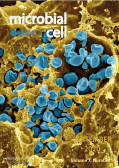Table of contents
Volume 7, Issue 9, pp. 222 - 254, September 2020
Cover: Scanning electron micrograph of a murine macrophage infected with Francisella tularensis (strain LVS), the causative agent of tularemia, also known as rabbit fever. Macrophages were dry-fractured by touching the cell surface with cellophane tape after critical point drying to reveal intracellular bacteria. Francisella tularensis cells (colorized in blue) are located either in the cytosol or within a membrane-bound vacuole (image by the National Institute of Allergy and Infectious Diseases, National Institutes of Health (USA); the image was modified by MIC). The cover is published under the Creative Commons Attribution (CC BY) license.
Enlarge issue cover
Regulation of the mitochondrial permeability transition pore and its effects on aging
Damiano Pellegrino-Coppola
Viewpoint |
page 222-233 | 10.15698/mic2020.09.728 | Full text | PDF |
Abstract
Aging is an evolutionarily conserved process and is tightly connected to mitochondria. To uncover the aging molecular mechanisms related to mitochondria, different organisms have been extensively used as model systems. Among these, the budding yeast Saccharomyces cerevisiae has been reported multiple times as a model of choice when studying cellular aging. In particular, yeast provides a quick and trustworthy system to identify shared aging genes and pathway patterns. In this viewpoint on aging and mitochondria, I will focus on the mitochondrial permeability transition pore (mPTP), which has been reported and proposed as a main player in cellular aging. I will make several parallelisms with yeast to highlight how this unicellular organism can be used as a guidance system to understand conserved cellular and molecular events in multicellular organisms such as humans. Overall, a thread connecting the preservation of mitochondrial functionality with the activity of the mPTP emerges in the regulation of cell survival and cell death, which in turn could potentially affect aging and aging-related diseases.
Systematic analysis of nuclear gene function in respiratory growth and expression of the mitochondrial genome in S. cerevisiae
Maria Stenger, Duc Tung Le, Till Klecker and Benedikt Westermann
Research Reports |
page 234-249 | 10.15698/mic2020.09.729 | Full text | PDF |
Abstract
The production of metabolic energy in form of ATP by oxidative phosphorylation depends on the coordinated action of hundreds of nuclear-encoded mitochondrial proteins and a handful of proteins encoded by the mitochondrial genome (mtDNA). We used the yeast Saccharomyces cerevisiae as a model system to systematically identify the genes contributing to this process. Integration of genome-wide high-throughput growth assays with previously published large data sets allowed us to define with high confidence a set of 254 nuclear genes that are indispensable for respiratory growth. Next, we induced loss of mtDNA in the yeast deletion collection by growth on ethidium bromide-containing medium and identified twelve genes that are essential for viability in the absence of mtDNA (i.e. petite-negative). Replenishment of mtDNA by cytoduction showed that respiratory-deficient phenotypes are highly variable in many yeast mutants. Using a mitochondrial genome carrying a selectable marker, ARG8m, we screened for mutants that are specifically defective in maintenance of mtDNA and mitochondrial protein synthesis. We found that up to 176 nuclear genes are required for expression of mitochondria-encoded proteins during fermentative growth. Taken together, our data provide a comprehensive picture of the molecular processes that are required for respiratory metabolism in a simple eukaryotic cell.
A new role for proteins subunits of RNase P: stabilization of the telomerase holoenzyme
P. Daniela Garcia and Virginia A. Zakian
Microreviews |
page 250-254 | 10.15698/mic2020.09.730 | Full text | PDF |
Abstract
RNase P, an RNA-protein complex, is essential for processing tRNAs. Three of the ten protein subunits of Saccharomyces cerevisiae RNase P (and a related complex, RNase MRP) co-purify with yeast telomerase, another RNA-protein complex. The three telomerase-associated proteins, Pop1, 6 and 7, bind to TLC1, the RNA subunit of telomerase. In a recent study (Garcia et al. Nat Commun), we used temperature sensitive alleles of the essential POP genes to determine their role in telomerase biogenesis. At permissive temperature, pop mutant cells grow normally, and the abundance of most proteins, including protein subunits of telomerase, is similar to wild type (WT). However, telomeres are short, and the amount of the mature telomerase holoenzyme is low. Unlike the RNA subunit of RNase MRP, TLC1 is more abundant in pop cells and properly folded, except at the Cs2a/TeSS domain where the Pop proteins bind. These defects correlate with defective movement of TLC1 from the cytoplasm, where it associates with telomerase proteins, back to the nucleus where it lengthens telomeres. Thus, Pop proteins are needed for the stable association of telomerase proteins with TLC1, and their reduction sequesters mature telomerase in the cytoplasm, away from its nuclear substrates.










